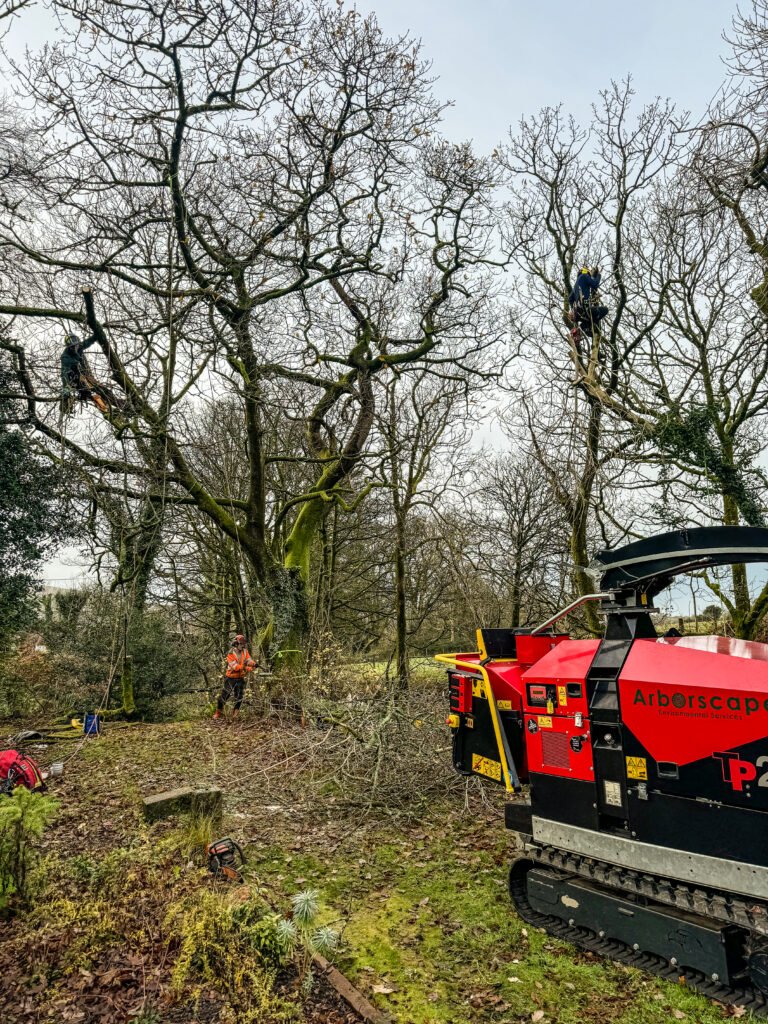Enhancing Structure, Health & Wildlife Value
Pruning Oak trees: These are some of the most iconic and ecologically valuable species in the world. From the native English oak to the evergreen holm oak and the large North American species, oaks are not only majestic garden features but also keystones for biodiversity. Correct pruning ensures structural integrity, long-term health, and allows these trees to continue providing essential ecological benefits. This guide covers best practices for Quercus robur, Quercus rubra, Quercus ilex, Quercus macrocarpa, and Quercus alba.
Why Oaks Matter Ecologically
Oaks are ecological powerhouses, supporting thousands of species:
- Habitat Provision: Dense branching and cavities provide nesting sites for birds, bats, and small mammals.
- Food Source: Acorns feed deer, squirrels, jays, and other wildlife. Flowering in spring supports pollinators, while the leaf litter sustains insects and soil organisms.
- Biodiversity Support: Oaks host hundreds of insect species, including moth and butterfly larvae, which in turn feed birds.
- Carbon Storage & Climate Benefits: Oaks store large amounts of carbon in wood and soil while providing shade and reducing urban heat.
- Soil Stabilisation: Extensive root systems prevent erosion and improve soil structure.
- Ecological Corridors: Mature oaks form part of green networks, linking habitats and aiding wildlife movement.
Pruning done responsibly helps preserve these ecological benefits while maintaining tree health.
When to Prune Oak Trees
Oaks are prone to disease and sap bleeding if pruned at the wrong time.
- Best time: Mid to late winter, when the tree is fully dormant.
- Avoid: Spring and early summer, when sap rises and insect activity is high.
- Summer pruning: Only for removing broken, damaged, or hazardous limbs.


General Pruning Principles for Oaks
- Remove dead, diseased, or rubbing branches first.
- Maintain a strong central leader in young trees.
- Thin selectively rather than removing large limbs.
- Do not top or heavily reduce—oaks react poorly to drastic cuts.
- Use clean, sharp tools and make cuts just outside the branch collar.
Oaks grow slowly, so early, light pruning is preferable to major intervention later in life.
Pruning Specific Oak Species
Quercus robur (English Oak)
- Encourage well-spaced scaffold branches around a central trunk.
- Remove competing leaders early.
- Mature trees should only have safety pruning; excessive cuts reduce flowering and acorn production, affecting wildlife.
Quercus rubra (Red Oak)
- Maintain a dominant central leader.
- Remove steeply angled or crossing branches.
- Moderate thinning improves airflow, helping insects, birds, and bats use the canopy more efficiently.
Quercus ilex (Holm Oak)
- Thin congested growth to allow sunlight penetration for understory plants and insects.
- Lift lower branches to provide ground-level habitat for small mammals.
- Evergreen leaves maintain winter cover and foraging opportunities for birds.
Quercus macrocarpa (Bur Oak)
- Prioritize structural pruning early to prevent weak forks.
- Mature trees should have minimal pruning; old limbs host cavity-nesting birds and bats.
- Large leaves and thick bark provide habitat for mosses, lichens, and invertebrates.
Quercus alba (White Oak)
- Maintain balanced branch spacing for long-term stability.
- Retain old, thick limbs whenever possible, as they develop tree cavities critical for owls, woodpeckers, and bats.
- Minimal pruning preserves flowering and acorn production, supporting wildlife food webs.
Additional Ecological Benefits of Pruning Oaks
When pruning is done correctly, it can enhance the tree’s ecological role:
- Increased Sunlight Penetration: Lightly thinning the canopy allows understory plants to flourish, increasing overall biodiversity.
- Habitat Diversity: Removing diseased or crossing branches reduces deadfall risk, but leaving some deadwood provides habitat for insects and fungi.
- Enhanced Acorn Production: Correct formative pruning encourages healthy branch growth, resulting in better flowering and more acorns for wildlife.
- Airflow and Disease Prevention: Thinning reduces fungal infections, which protects the tree and maintains its long-term ecological function.
Final Thoughts
Oaks are long-lived giants that provide unparalleled ecological, aesthetic, and cultural value. Proper pruning—done lightly, with careful attention to timing and structure—supports their health, stability, and biodiversity role. By caring for Quercus robur, Q. rubra, Q. ilex, Q. macrocarpa, or Q. alba, you’re not only preserving a magnificent tree but also protecting the countless species that depend on it.
As oaks can grow particularly large, special access knowledge and equipment can often be needed. We have state of the the art equipment, expertise and experience and can be on hand to safely prune your trees and remove the waste, leaving you with a beautiful green space to enjoy. Contact us for more information.
